
MAY CONTAIN NUTS

Search Shorpy
SHORPY ART

Framed or unframed, desk size to sofa size, printed by us in Arizona and Alabama since 2007. Explore now.
Join and Share
Ad-Free Shorpy
Shorpy is funded by you. Patreon contributors get an ad-free experience.
Learn more.

Recent comments
- Baldwin 62303
- Baldwin VO-1000
- Cold
- No expense spared
- Tough Guys
- Lost in Toyland
- And without gloves
- If I were a blindfolded time traveler
- Smoke Consumer Also Cooks
- Oh that stove!
- Possibly still there?
- What?!?
- $100 Reward
- Freeze Frame
- Texas Flyer wanted
- Just a Year Too Soon
- WWII -- Replacing men with women at the railroad crossing.
- Yes, Icing
- You kids drive me nuts!
- NOT An Easy Job
- I wonder
- Just add window boxes
- Icing Platform?
- Indiana Harbor Belt abides
- Freezing haze
- Corrections (for those who care)
- C&NW at Nelson
- Fallen Flags
- A dangerous job made worse
- Water Stop
Member Photos
The Shorpy
Print Emporium
Print Emporium
Search Shorpy
Search results -- 30 results per page
- Las Vegas Club: 1951
- ... 35mm Kodachrome transparency. View full size.
Neon was king What else can one say. Keeping all that functioning was a very ... in Las Vegas for one night. I don't gamble, but the neon signs were spectacular and the people watching entertaining. Here is a ... Posted by Dave - 08/01/2021 - 5:49pm -
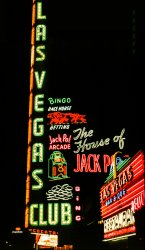
- The Hotel Essex: 1906
- ... -- always the same letters -- were often out in the neon sign on the roof, resulting in HOT SEX. Clearly, this was not due to ...
[Oh right. Not gone! - Dave]
Despite certain neon letters not working properly ... this is the cleanest 1906 photograph ... Posted by Dave - 02/09/2024 - 4:53pm -
![The Hotel Essex: 1906 Boston circa 1906. "Atlantic Avenue elevated at Hotel Essex (Terminal Hotel)." Completed in 1900, now the Plymouth Rock Building. 8x10 glass negative, Detroit Publishing. View full size.
How could they resist?I can attest that certain letters -- always the same letters -- were often out in the neon sign on the roof, resulting in HOT SEX. Clearly, this was not due to chance, but creative vandalism.
Gone? Then what is this?https://maps.app.goo.gl/HeJRkk4dkxWC9dP79
Really echoes the architecture of the Hotel Essex. Is this just a similar building in a close location (next to South Station. I guess if it was industrial, then look alike buildings could be all over I guess?)
[Oh right. Not gone! - Dave]
Despite certain neon letters not working properly... this is the cleanest 1906 photograph I've ever seen.
Fireproof, as featured inFireproof Magazine, July 1906. No interior photographs or floorplans, but the architect is identified, Arthur Hunnewell Bowditch. His Wikipedia page doesn't include the Hotel Essex among his notable projects. But, in 1931/32 he designed the Art Deco Paramount Theater, the last of the great movie palaces built in downtown Boston.
Looking at the two 1906 photographs and Street View, I'm certain there was a second-floor entrance to the Hotel Essex, directly from the elevated train platform. A nice perk for guests.
If only --So 120 years ago, I could walk to my local train station and arrive at South Station, walk out and up the stairs to wait for the next elevated train to my office at North Station. But today, I have to go below ground and take two overcrowded subway rides to get to the same location. MBTA, please bring back the Atlantic Avenue line!
Platform AdsOne of the advertisements I can see on the platform is for Mennen's Toilet Powder. The rest are inscrutable to me.
(The Gallery, Boston, DPC, Railroads)](https://www.shorpy.com/files/images/SHORPY-4a13543a.thumbnail.jpg)
- Howard's Chicken Shack: 1943
- ...
https://goo.gl/maps/UuGw392TpYw
re: Custom Neon Harold probably got much of his sign's cost paid for by 7-Up for advertising rights.
Custom Neon Howard must have been pretty prosperous to afford custom neon on his ... Posted by Dave - 07/03/2016 - 12:14pm -
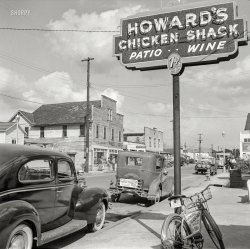
- All Lit Up: 1910
- ... on the boardwalk at S Kentucky Avenue.
Early neon lights? The Moerlein's and Spearmint signs appear to be neon lights. If so, they must be very early examples of that art form.
... Posted by Dave - 04/01/2023 - 1:37pm -
![All Lit Up: 1910 Atlantic City, New Jersey, circa 1910. "The Boardwalk at night." 8x10 inch dry plate glass negative, Detroit Publishing Company. View full size.
Double ChairsSmith's double chairs appear to be simply the famous Atlantic City rolling chairs for two. We know the exact date they were introduced there: June 11, 1887. TripAdvisor says that that 50-cent ride will cost you about $40 today.
Incredible detailOutstanding photo.
Somebody call GhostbustersI’ve never seen so many spectral bodies in one place before.
Only the ghosts come out at nightHere is as close to a comparative daytime view as I could find, looking down from the Hotel Traymore about four years earlier. The only sign I can see for sure in both photos is Moerlein's Barbarossa, which Google tells me is a dark lager brewed in Cincinatti, Ohio.
I couldn't identify any of the 1910 buildings in Street view. Based on where the Hotel Traymore was located and a slight dogleg in the boardwalk that you can see in the 1906 photo, here is where I think the nighttime photo was taken, on the boardwalk at S Kentucky Avenue.
Early neon lights?The Moerlein's and Spearmint signs appear to be neon lights. If so, they must be very early examples of that art form.
[Light bulbs only -- no neon. - Dave]
Boardwalk rolling chairsAt one period after this photo two rolling chair lanes were created with boards going the opposite direction which created a smoother ride for rolling chair riders. All the rolling chairs in the photo have hard tires. Only one company (Eveler) had rolling chairs with balloon tires. The others (Shill, G. George, etc.) used hard rubber.
(The Gallery, Atlantic City, DPC)](https://www.shorpy.com/files/images/SHORPY-4a55246a.thumbnail.jpg)
- Kodachrome Vegas: 1958
- ... too And parked at the curb at left, a 1958 Rambler.
Neon Kodachrome A beautiful photo. I love the colors. The 'CLUB' sign in the upper left corner has a curious appearance of neon green outlines at only the outermost points on the illuminated letters. A ... Posted by Deborah - 01/16/2013 - 7:57pm -
![Kodachrome Vegas: 1958 Classic Las Vegas -- Fremont Street. 35mm Kodachrome film taken by my father-in-law, Woodrow Humphries. I'm guessing 1958 or so. The Westerner was open from 1950 to 1962. The Mint and The Boulder Club (with its famous sign) are on the right edge. The marquee above the Nevada Club was a late-'50s addition. Any other thoughts are welcome. I just noticed the VW Beetle! View full size.
KudosAmazing photo. Car is the foreground is a 1958 Chevrolet.
Kudos tooAnd parked at the curb at left, a 1958 Rambler.
Neon KodachromeA beautiful photo. I love the colors. The 'CLUB' sign in the upper left corner has a curious appearance of neon green outlines at only the outermost points on the illuminated letters. A neat effect from however Kodachrome reacts to the combination of incandescent and neon lighting.
Is that a searchlight in front of the Nevada Club?
[The much-brighter incandescents are blown out (grossly over-exposed) either on the film or, more likely, the scan, thus bleeding over and obscuring the neon outlines. Film still has the edge over digital in dynamic range. - tterrace]
Union PacificSeeing the Union Pacific depot at the far end of the street reminds me of riding the train. During the 50's my family would ride the Challenger from the East LA station to North Platte, Nebraska to visit relatives. When we stopped in Las Vegas, late at night. I would step off the train and watch the lights of Fremont Street while my dad had a cigarette. Thanks for the memory.
Stunning Image!Kodachrome and Vegas neon; what a combination!
There's something about the way Kodachrome reacted to and rendered green that is always eye-catching, but this is just amazing.
I wonder if they still make Cibachrome prints?!??! I'll take this in a 24" x 36", gloss lammed, on black Gator Board, please.
Nice to see Vegasbefore it got gaudy.
Henderson Home NewsHere's a newspaper that shows the exact same headliners at the Nevada Club from August 20, 1959.
Music music musicI see the Hilltoppers headlining the marquee, and their site lists them as being active from 1952 to 1957, so pretty good chance this is 1958.
Tuesday NightsYou might get the feel of this place and time watching the new CBS show "Vegas".
Car guy's eyeI noticed the '58 Rambler and '58 Chevy first thing. My first car was a '58 Rambler, a gift from my parents, well-used by the time I got it. It had its good points, but style was not one of them. The Chevy came from another universe; a universe where things were beautiful.
Visiting the old Golden NuggetWhat a beautiful picture this is of the old downtown Vegas. I used to love visiting the old Golden Nugget years back. I loved the old downtown area when I was a young kid. My folks used to let us see downtown as we drove through Vegas to visit with my godfather who lived just outside of downtown. I later gambled and usually ate at the Golden Nugget casino there on visits in the early 70's. I loved the howdy pardner sign down the street. I remember when Glenn Manning who was the giant man from the "The Amazing Colossal Mant" movie, tore down the frontier and howdy partner sign on the set for the movie.
Fremont StreetI was on Fremont Street just a couple of weeks ago. The Plaza Hotel is still there, recently remodeled. The Golden Nugget is probably the nicest hotel on the street, but the casino is pretty tight compared to Binion's across the street. The Golden Gate, right at the end of the street and across from the Plaza, has a really nice little cafe called Du Par's. The giant cowboy is still there and hopefully will be forever.
Live It Up (at the Union Plaza)@rfleischer, The Union Pacific station continued to operate in that location as long as passenger trains served Las Vegas, Amtrak's 'Desert Wind' being the last scheduled train to leave the station in 1997.
There was a lovely moderne station on the site until it was demolished to make way for the Union Plaza Hotel (last I knew it was known simply as the Plaza). Passengers continued to be served by a station on the UP property connected to the hotel.
It was very convenient to step out of the train and into the hotel, as I did more than a few times. From time to time, there are reports or rumors of a LA - LV passenger train being resurrected but I wouldn't hold my breath.
@Vintagetvs Quite right! Before they tarted it up, "The Meadows" was a nice place to go for a tranquil holiday.
Not Just a 58 RamblerBut a 1958 Rambler DeLuxe, which meant there was no side trim or excess chrome (though still more chrome than 10 cars put together by today's standards). And instead of two headlamps on each side, there is only one. Many were sold as fleet vehicles, taxis and government use.
I purchased this model in 1996 and restored it. Despite its clunky family car look, I won my share of awards and trophies. Mine had the pushbutton transmission.
A Roof Over ItPrevious posters failed to mention that this part of downtown Vegas now has a roof over it. It is the called the Fremont Street Experience. It's referred to as a "light canopy." The screen contains 12.5 million synchronized LED lamps, including 180 strobes and eight robotic mirrors per block. You have to see it to believe it. As Mr. Mel mentioned, check out "Vegas" on CBS, 10 pm on Tuesdays. Great show set in the early 60s. Or watch the original Ocean's 11 movie, with Frank Sinatra and the Rat Pack.
1959 ModelBehind the searchlight trailer it looks like there is a 1959 Mercury or Ford station wagon.
Since the dark wood does not appear to go above the front wheel it cannot be a 1958 Mercury, and since there is no center hood scoop it cannot be a 1958 Ford.
[The car is a 1959 Mercury Colony Park. - Dave]
More CarsBehind the Beetle is what looks like a 1955 Plymouth (it's hard to tell), followed by a 1956 Pontiac. We had one of the Pontiacs; it was the first car I ever drove.
August 1959@SouthHammond63 – good find.
(ShorpyBlog, Member Gallery)](https://www.shorpy.com/files/images/Woodrows_Vegas_Slide_0.thumbnail.jpg)
- Neon Texaco: 1951
- "Las Vegas 1951." Today's first Kodachrome, of the gas station at the Hotel Last Frontier, comes to us by way of the late Don Cox, 70 years after he snapped the shutter. View full size.
(The Gallery, Kodachromes, Don Cox, Gas Stations) ... Posted by Dave - 08/02/2021 - 3:27pm -
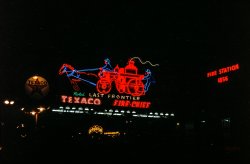
- Neon Naons (colorized)
- Colorized version of Five Little Naons: 1912 . View full size.
(Colorized Photos) ... Posted by motobean - 01/21/2010 - 1:49pm -
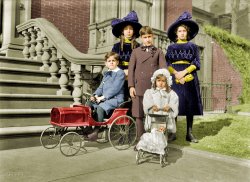
- Arizona Motel: 1942
- ... court. Phoenix, Arizona." An early example of Desert Neon Noir. Medium format negative by Russell Lee for the Farm Security ... (or spherical) thing hanging to the right of the neon sign? It appears to be inside (or outlined by) a cage-like (for lack of a ... Beautiful sign I love the little detail of the 2 short neon tubes on the bottom of the sign that light up the AAA panel.
Sign of ... Posted by Dave - 05/11/2022 - 4:09pm -
![Arizona Motel: 1942 February 1942. "Tourist court. Phoenix, Arizona." An early example of Desert Neon Noir. Medium format negative by Russell Lee for the Farm Security Administration. View full size.
Business trip ...Or family vacation? Whatever it is, the photograph is great! But what's puzzling me is the scrotum hanging on the crossbar to the right of the sign.
Going out on a limbI am loath to reveal such ignorance but where better to be set straight than here? WHAT is that disc-shaped (or spherical) thing hanging to the right of the neon sign? It appears to be inside (or outlined by) a cage-like (for lack of a better term) structure made of woven rope. Is it a nest or hive? It looks vaguely snakelike. And those are all the clues I'm going to give you.
[It is the counterweight on a neonized version of an old-school well sweep. - Dave]
Once again y'all do not disappoint. I would never in a million years have got that lid off on my own but would you have got it off if I hadn't loosened it for you? Just saying. I mean, just kidding.
Beautiful signI love the little detail of the 2 short neon tubes on the bottom of the sign that light up the AAA panel.
Sign of a weighty matterThat big suspended ball to the right of the motel sign appears to be a counterweight holding the sign up. Why all that to hold a sign up? Perhaps it was to apply a traditonal abobe-style way of holding a sign up, in keeping with style of the motel. If in fact that sign setup is in keeping with the adobe motif.
Balancing Act?I'm betting that's a natural rock or poured concrete round boulder carefully tied and used as a counterweight for the motel sign. Pretty clever and a good use of resources.
Look out below!A counterweight to that neon sign, hung from a dead tree branch.
I would advise you not to stand (or park your car) underneath it.
Introducing the 1941 MercuryHere’s an original dealer training film that details the features of the all-new Mercury line for 1941.
https://www.youtube.com/watch?v=05cUGrerGKs
Non-noir versionLet the sunshine in!
Still there -- sort ofIt's been remodeled and is now transitional housing. Better than being razed to the ground like so many other things in Phoenix.
Nice NeonSuch an evocative photo! If only it could have been in color.
"Air Cooled"So is "Air Cooled" could mean airconditioning, a swamp cooler, or even a fan. I wonder which it was?
I'm impressedit lasted long enough to be remodeled and remodeling was chosen over demolition. The remodeling is fairly recent; attached is a combined Google Maps photo showing before remodeling and Google Earth photo showing during. It looked to be in pretty bad shape.
Click to embiggen.
Lit UpIn response to those desiring a colorized look, at the neon sign, my feeble attempt.
Glowing PraiseI really like the neon Shorpy!
Lone Snag MotelSeen here some 17 years later (both visible cars are 1959 vintage), the sign and counterweight are gone, but the dead tree still stands.
(The Gallery, Cars, Trucks, Buses, Russell Lee)](https://www.shorpy.com/files/images/SHORPY-8c23999a.thumbnail.jpg)
- 13 Inch Lunch: 1942
- ... Morris! That has to be the best sign.
Makeshift Neon This establishment would have stood out at night, since neon tubing is in evidence. At the peak of the roof is the word BEER, and below ... Posted by Dave - 09/23/2022 - 3:14pm -
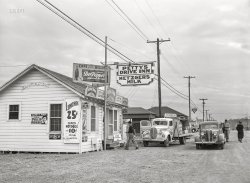
- Last Call: 1942
- ... out there get stuck on either side of that fence?
Neon — Any chance of finding a photo of what appears to be a huge neon sign on the front of the station?
[Aside from the photo you were ... Posted by Dave - 09/05/2022 - 4:39pm -
![Last Call: 1942 May 14, 1942. Washington, D.C. "Filling up with gas on the day before rationing starts." 4x5 inch acetate negative by John Collier for the Office of War Information. View full size.
Even or odd? In the 1970s, I remember my parents were relieved that one of our cars had an odd-numbered license plate and the other an even-numbered one. They were extra happy they had bought a new high MPG Honda that year, despite the fact it put us at odds with the rest of friends and family.
Anyone out there get stuck on either side of that fence?
Neon —Any chance of finding a photo of what appears to be a huge neon sign on the front of the station?
[Aside from the photo you were just looking at? - Dave]
Washington Rubber Co. Cheaters!In January 1943, only seven months after rationing started, Washington Rubber Co. was suspended from gasoline transactions for two months due to violating gas ration orders. In our nation's capital!
The citation referenced the location as Fourteenth and Belmont Streets N.W. In another photo Dave posted, the still standing Clifton Terrace Apartments in the background (thanks Notcom) would place our busy Conoco station here.
Car on the far rightThat suicide door is HUGE!
(The Gallery, Cars, Trucks, Buses, D.C., Gas Stations, John Collier, WW2)](https://www.shorpy.com/files/images/SHORPY-8c26558a.thumbnail.jpg)
- Calf Fries Coming Up: 1942
- ... friend tells you what they are.
Bull Calf had neon running along its eave On Street View I checked the phone poles around ... Posted by Dave - 09/26/2022 - 11:04am -
![Calf Fries Coming Up: 1942 January 1942. "Roadside cafe. U.S. Highway 80, Texas, between Dallas and Fort Worth." Acetate negative by Arthur Rothstein for the Office of War Information. View full size.
No potatoes involvedCancelled my order. Turns out Calf Fries are in no way related to French Fries.
Calf Fries!Known colloquially as "Swingin Steak".
The NSFW menu"If you don't know about 'em you haven't lived in the Southwest for very long": as they say, ignorance is bliss.
Prairie oystersThat’s what they call them in western Canada.
Prairie oysters: Having a ball in CalgaryIn Canada calf fries are known as prairie oysters, and there was even a 1970s country and western music group from Ontario called Prairie Oyster. This story will tell you everything you need to know.
Remembrance I lived in that area for years but what got my attention was the root beer sign at
the end of the building.
When I was young in the '60s I remember the billboards that used to advertise
Hires root beer with
"HIRES TO YA"
Whenever I see a Hires sign, I think of it; Not to mention I always said it aloud.
Calf Fries Coming Up… or maybe Coming BACK up after your prankster friend tells you what they are.
Bull Calf had neon running along its eaveOn Street View I checked the phone poles around where I think this photo was taken to see if I could find the same numbers today. No luck. Bull Calf doesn't seem like a proper name for this place, more like very targeted advertising. There appears to be numbers over the door. Dave, can you read those numbers?
[1218 -- the 1937 Dallas City Directory locates the Bull Calf at 1218 West Davis Street. The 1942 Directory shows the Bull Calf and its neighbors Jake's Auto Parts No. 2 and Hudson Oil filling station (seen in this photo and in the next post) located on West Commerce. So it seems the building was moved from Davis to Commerce with the old address number still over the door. - Dave]
(The Gallery, Arthur Rothstein, Eateries & Bars)](https://www.shorpy.com/files/images/SHORPY-8b16432a.thumbnail.jpg)
- Drink Gluek: 1940
- ... Minneapolis, these signs bring back memories of crowded neon over the sidewalk. I think I see a Fitgers sign in the middle. That ... regional in distribution at this time.
Your Beer in Neon That Gluek's neon sign must have served as a beacon in the stormy night ... Posted by Dave - 01/05/2013 - 12:42pm -
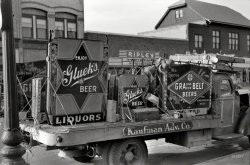
- Co-op Gas: 1941
- ... still in business.
The things you find out here --
Neon Tower I'd love to see a night photo of this Moderne gas station, since the tower has lots of neon tubing on it. There is some neon around the overhang as well. Canada has ... Posted by Dave - 02/13/2020 - 8:31pm -
![Co-op Gas: 1941 August 1941. "Cooperative gas station in Minneapolis, Minnesota." Medium format acetate negative by Marion Post Wolcott for the Farm Security Administration. View full size.
Co-Op Doo-WopThis photo has a very 1950s look to it. I suppose life, fashion, architecture and design in particular, took a break during the '40s while all efforts focused on WWII. Sometimes I wonder how different the 1950s would have been if the war had never taken place.
I only know of co-ops in New York CityI thought co-ops were member owned apartments in the Big Apple. Well, they are.
I didn't know about other co-op ventures, like this service station. By the way, if you look by the left shoulder of the attendant, you'll see Walker Mufflers for sale.
I did a search on Walker exhaust and muffler systems, and by golly, they are still in business.
The things you find out here --
Neon TowerI'd love to see a night photo of this Moderne gas station, since the tower has lots of neon tubing on it. There is some neon around the overhang as well. Canada has lots of Co-op gas stations, particularly on the Prairies and in the West. Here is a list of Co-op stations on Vancouver Island, with the Canadian term "gas bar" used.
Fill it Up?Just think, most people under 40 or so have never had a person come out and fill up their tank at the gas station.* I remember the first time I had to do it myself. It was down south in 1976. We ended up with self-serve up north where I lived a few years later.
[*Unless you live in New Jersey or Oregon. - Dave]
TiresI remember when they came spiral-wrapped in brown paper.
August 1941Four more months that pile of tires will be just a memory. All the rubber for the war effort among a host of other sacrifices by Americans and their families.
Co-OpedThere was a Co-Op gas station in my home town in central Ohio in the 1950s and '60s. It was part of the Farm Bureau agricultural supplies center, which was run as a cooperative with local farmers.
CO-OP ragtopWow! All the way from Virginia in a 1941 Buick convertible (rag top).
Probably not many convertibles in Minneapolis due to the short top down season and long northern winters. Pre-war good times.
Red River Co-opThe full name of the Co-op gas stations and supermarkets in Manitoba is Red River Co-op. Photos below are of Winnipeg, my hometown.
The Virginian brideA plausible candidate for the driver of the car in the Minneapolis gas station in August 1941 with Virginia plates is photographer Post Wolcott. Before the war and rationing FSA photographers drove more than they hopped trains. We know Marion Post had wed Leon Oliver Wolcott by August because her colleague John Vachon reported the news to his wife Penny in a June 27, 1941 letter. Her groom was a deputy director of a section of the Department of Agriculture, and in her 1965 oral history she explained that her marriage came with two children and a farm. Her Smithsonian bio places the farm in Virginia. Before August 1941 was over, her car had reached grain elevators in Minot, North Dakota, dude ranchers in Birney, Montana and a farm family in Laredo, and main street in Sheridan, Wyoming.
Massachusetts has a local option Attendant required to fill tank in the next town over.
Yeah, it's weird. Since only the folks who live there are inexperienced at filling their own tanks. The rest of us come from places where we're trusted to manage on our own. It's a "safety" thing, I guess, like the stickers requiring you to turn off your cellphone while filling, which seem to have disappeared.
(The Gallery, Cars, Trucks, Buses, Gas Stations, M.P. Wolcott, Minneapolis-St. Paul)](https://www.shorpy.com/files/images/SHORPY-8c15191a.thumbnail.jpg)
- Veribest Canned Meats: 1900
- ... on my wall! Thanks Dave, that's funny!
They say the neon lights are bright ... on Broadway, and we have O.J. Gude to thank:
... Posted by Dave - 08/02/2012 - 4:16pm -
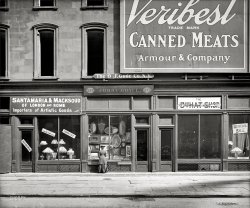
- Bus Kennel: 1943
- ... for the Office of War Information. View full size.
Neon Greyhound Dog Running In case haven't seen what the old Greyhound neon signs looked like in action.
Eagle Down Both of those eagles ... Posted by Dave - 02/25/2017 - 1:25pm -
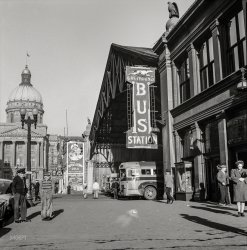
- Foot Traffic: 1942
- ... just destroys the simplicity of the original design.
Neon The glow framing the large second-story window comes from the store name mounted vertically in neon lights.
Morris Lapidus Morris Lapidus also designed the ... Posted by Dave - 09/07/2013 - 11:42am -
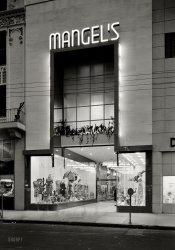
- Best Deal in Town: 1936
- ... one on Market St. in 1942. -tterrace]
Pontiac in Neon It appears Mr. Herzog was quite the promoter. That Pontiac with the hood outlined in neon must have been quite the sight in 1936.
Upstairs, Downstairs "OK, ... Posted by Dave - 02/19/2015 - 12:59pm -
![Best Deal in Town: 1936 Labor on the left, management on the right. Everyone smile!
June 3, 1936. "J.A. Herzog Pontiac, 17th & Valencia Sts., San Francisco." 8x10 inch acetate negative originally from the Wyland Stanley collection. View full size.
Birdcage signalUnique to San Francisco were the "birdcage" traffic signals invented in the 1920s by SF's Engineer of Underground Construction, Ralph W. Wiley. I remember many of these still being in operation in the mid-1950s; the last of them were removed in 1958 or 1959. Apparently only 20 or so are still in existence; here's an exciting video of one that's been restored to working condition.
Road BarnaclesWhat are the big round covers on the street?
[The buttons were a way to designate a streetcar safety zone, like this one on Market St. in 1942. -tterrace]
Pontiac in NeonIt appears Mr. Herzog was quite the promoter. That Pontiac with the hood outlined in neon must have been quite the sight in 1936.
Upstairs, Downstairs"OK, everyone who showers BEFORE work, please stand on the right. And everyone who showers AFTER work, please stand on the left."
Used car specials!I wonder what they're asking for the '32 Marmon? It would be tough to get parts: Marmon went tango uniform a few years earlier. My grandfather was of the unlucky associates to feel the Depression hit home with that closure.
The buildingBut, bloody and unbowed, it still stands.
[The building now on the site dates from 2002. -tterrace]
Pontiac “Dart”I never realized that the Pontiac “Dart” is a Native American Arrowhead, until I read it in Five Fascinating Things You Didn’t Know About Famous Car Logos by Joshua Johnson.
(The Gallery, Cars, Trucks, Buses, San Francisco, W. Stanley)](https://www.shorpy.com/files/images/SHORPY-256-01.thumbnail.jpg)
- Streets of San Francisco, Cont'd
- ... SF Bay Area history project , with Ron's permission.
Neon everywhere! That street must have been quite a sight at night! I'm really looking forward to the day when old-fashioned neon signs become so antiquated as to be fashionable again. I really miss them! ... Posted by rsyung - 07/28/2014 - 3:36pm -
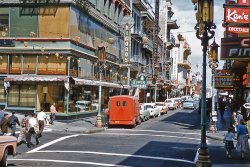
- Sidewalks of Springfield: 1910
- ... modern could it get, they asked?
On the threshold of NEON I want to eat at
THE
L
Y
N
C
H
LUNCH
That sign has ... I had to look it up on wikipedia to learn that the first neon signage was demonstrated in December 1910.
Sports Minus Two If TomR ... Posted by Dave - 04/17/2018 - 4:57am -
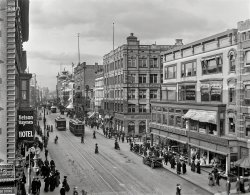
- Bellevue-Stratford: 1910
- ... the Hyatt. the lobby is virtually unchanged.
Budweiser Neon That very large Budweiser neon sign on the left side of the photo is exactly like the one that was in ... Posted by Dave - 09/13/2011 - 11:22pm -
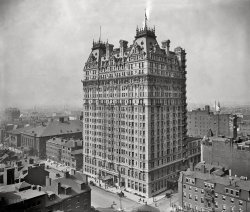
- Gurley-Lord: 1929
- ... dealership now, but still there.
Those neon signs. That neon sign on the roof is one sign and a half.
This business, judging by ... Posted by Dave - 01/13/2015 - 11:00pm -
![Gurley-Lord: 1929 "Gurley-Lord service station, San Francisco, 1929." One of eight 8x10 negatives showing rubber-related activities at Goodyear tire dealers. View full size.
Prest-O-Lite in 1923?Hard to imagine that there was much call for Prest-O-Lite acetylene gas service for auto lights in 1923, eleven years after the introduction of automotive electric starting and lighting systems.
[Acetylene-generating tanks were also in service on trucks, motorcycles, bicycles and camp stoves. -Dave]
Goodyear to FirestoneI'm not sure why, but I immediately recognized this as the automotive district near the DNA Lounge on 11th street. (Something about the sidewalk spacing?)
I found an address in a genealogy journal:
GURLEY-LORD TIRE CO, J F Gurley Pres, D A Lord V-Pres, Distributors of The General Tire, 1517 Mission at 11th, Tel HEmlock 1800
Looks like it's a Firestone dealership now, but still there.
Those neon signs.That neon sign on the roof is one sign and a half.
This business, judging by the quality of the signage, was a very successful and prosperous one.
Photo dateThe coupe (Durant ?) is much newer than 1923; probably 1928.
[Actually 1929. - Dave]
(The Gallery, Cars, Trucks, Buses, San Francisco)](https://www.shorpy.com/files/images/SHORPY-190-01.thumbnail.jpg)
- Evening in Chinatown, 1956
- ... in San Francisco's Chinatown, circa 1956. I like the neon signs. View full size.
Reminds me of Hitchcock's ... Novak's Jaguar all around SF? Way hip photo.
All that neon I love it, the sun's going down and all the neon signs are coming on. ... Posted by Rute Boye - 08/10/2012 - 7:59pm -
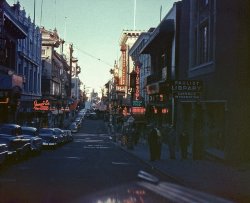
- Night on Catherine: 1954
- ... it doesn't look as "swinging" as it once did.
All that neon... ...would be thrown away by government decree in the 1970's thanks to ... Posted by Dave - 03/09/2008 - 3:07pm -
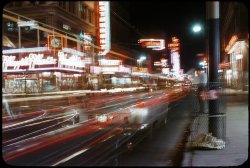
- Desert Hero: 1919
- ... ask a question and get an answer. Beautiful.
No Neon Yet? I'd love to see that Madison Theatre electric sign at night. What ... Posted by Dave - 10/11/2011 - 5:58pm -
![Desert Hero: 1919 Detroit circa 1919. "View of Madison Theatre and Woodward Avenue." Now playing: "Choosing a Wife" and Fatty Arbuckle in "A Desert Hero." 8x10 inch dry plate glass negative, Detroit Publishing Company. View full size.
A musical cityThere appears to be nine or ten piano companies in a two block area. How many more must there be that are out of frame?
OK, Now You're TalkingThis is my kind of picture. We've got awnings, theaters that show double features, an Edison Shop, trolley cars, piano stores, department stores, Old Glory with 46 stars, Coca-Cola signage, double-parkers, a Best Buy, an Apple Store, 4 Starbucks and I haven't finished looking yet.
[48 stars. - Dave]
Did you count them? I tried but couldn't. They look like uneven rows, the 48 star flag would have been a solid 6 rows of 8. The 46 star flag would have had both rows of 6 and 8.
[Some 48-star flags had staggered rows. - Dave]
Angel StatueI have to ask about the angel statue in the lower right, set into the parking area. What's up with that.
[It's looking at the angel across the street. - Dave]
Ha! noticed that soon after my comment, but, really, what's the story. I presume the City put them there since they're on 'public property'. More importantly, are they still there?
Thanks for the answer to my query! The beauty of SHORPY: ask a question and get an answer. Beautiful.
No Neon Yet?I'd love to see that Madison Theatre electric sign at night. What fun replacing bulbs!
John Breitmeyer's Sons FloristsIn the left background is the 8-story tall Breitmeyer Building. In the early 90's I was part of the architectural team that restored the building - except for the ground floor storefronts, it was almost completely original, and we restored those. The building was one of the first in Detroit that actively catered to African-American professionals (Doctors, Lawyers), giving it some historical significance. Originally, the entire first floor was a florist shop, and the basement contained huge brick boilers, which ran a steam engine for refrigeration equipment (all gone by the 90's). Attached is a picture of a paper model of the building I made at the time.
Pianos to the right of me, pianos to the left I seeLOVE the picture!
Remember that this was the year before broadcast radio got its start, so if you wanted some music, you played it yourself, either on a piano from one of 2000-odd US manufacturers, or on your Victrola (or Edison!) player.
It seems funny that in The Motor City, ten years into Henry's Model T, very few of the cars in this view are Fords.
Close to home Incredible!
As I type this, I'm sitting approximately behind the lower edge of the Schroeder Hardware Company sign on what we know as the Hartz Building at 1529 Broadway. This photo shows an incredible street scene on both Broadway and on Woodward, and no doubt was taken from high up in the Fyfe Shoes (now Fyfe Apartments) building at West Adams and Woodward. I can just make out the front of the Edelweiss Cafe on John R and Broadway and the cigar company water tower as shown earlier on Shorpy.
I'll let the owner of the Hartz Building know about this picture, as the building is positively full of large scale vintage prints.
Thanks Shorpy!
Hair's RestaurantReally?
[I recommend the soup. - Dave]
Angels of VictoryThe angels are long gone. I believe they were "angels of victory," part of a campaign to sell War Savings Stamps.
On the GridI'd hate to be the guy who had to keep all the bulbs lit in the Madison Theatre sign. The rectangle of lights in the center must have been used to spell out something. I wonder if it scrolled? If it did and the sign was animated, I'll bet it took a room full of equipment to do it.
(The Gallery, Cars, Trucks, Buses, Detroit Photos, DPC, Movies)](https://www.shorpy.com/files/images/SHORPY_4a25750a1.thumbnail.jpg)
- Tremont Street: 1923
- ... it could have a different plate.
Too early for neon If that Chevrolet sign is neon, then 1923 would be almost certainly too early for this photo. Neon signs ... Posted by Dave - 07/17/2012 - 10:40pm -
![Tremont Street: 1923 Boston circa 1923. "Tremont Street and the Mall." One of the later entries in the Detroit Publishing catalog. Note the big Chevrolet sign. View full size.
Boston BravesSeeing the sign "Baseball Today at Braves Field" jogged my memory.
As a kid collecting baseball cards in Cincinnati I can remember when they moved to Milwaukee in 1953 and their home field was in County Stadium.
I also remember when they moved from Milwaukee to Atlanta.
Still recognizable todayProminent is Park Street Church. The two granite subway kiosks hide a mirror image pair. The visible ones were removed decades ago. Many of the buildings are still there but with extensive modernization. Ah, the 1920s, when women weren't afraid to show a little leg!
Packard & HudsonThe first two cars parked on the near side of the street are a circa 1919 Packard with a 1920-21 Hudson Touring Limousine behind.
+85Below is the same view from May of 2008.
1923 or 1928?I'm certainly no fashion expert, but something about the way the ladies are dressed says late Twenties.
[The rubber says Early to Mid Twenties. If it were 1928 the cars would have balloon tires. - Dave]
Ain't she sweet?The woman in light colored clothing is turning more heads than the photographer. No doubt her companion is equally well turned out but she is mostly obscured by the man who was walking between her and the photographer's lens at the moment the shutter was opened.
Fashion datingKnee length skirts didn't come along until 1925 - circa 1923 they were way longer.
Date of PhotoThe 1923 posted date could be valid. Except for the front car, all the other nearby cars are sporting a POV 1922 Massachusetts license plate. The front car (a Packard) looks to be a Taxi - therefore it could have a different plate.
Too early for neonIf that Chevrolet sign is neon, then 1923 would be almost certainly too early for this photo. Neon signs were only introduced to the US in 1923, and it's unlikely that Boston would have had one of the first in the country.
[It uses light bulbs. - tterrace]
Boston 1924This photo, dated 1924, does not show the Chevrolet sign (from a different angle, but for reference match the Coca-Cola sign to the Salada Tea sign in this photo.) Photos dated 1927 and later in that set do show the sign.
1928 without a doubtThe third car in, the one with the street sign in front of it is a 1928 Essex, the one in front of that a c.1921 Hudson, and the first car, the black one, is a 1926 or 1927 Packard. The The Essex and Packard DO have balloon tires. And no respectable women in Boston would have worn skirts so short prior to 1925.
Tremont St. Boston ca1923.The R.H. Stearns department store, right side of Tremont, stands today as elderly housing. Is the wireless antenna structure in the background on the building closer to us than the Tremont Theater (later Tremont Temple), on atop the Theater itself? TIA
It appears the Chevrolet sign is either atop the Tremont House hotel, or across Beacon St. on the building that was leveled in the 1970's for the 1 Beacon St. highrise, home of the Boston Gas Co. and an underground, 2-screen Sack's cinema. HTH.
(The Gallery, Boston, DPC)](https://www.shorpy.com/files/images/SHORPY_4a24958a.thumbnail.jpg)
- Cafe Ginza: 1941
- ... really gets your attention! Smart advertising.
Nisei Neon Great early birthday presents to me to peer back into everyday American ... paranoias of 1942, I hope somebody at least rescued their neon sign, as it's fantastic. And the movie posters somehow look much later ... Posted by Dave - 12/07/2012 - 3:19pm -
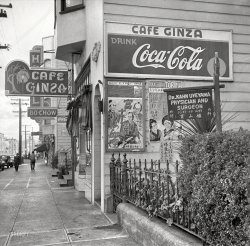
- Washington Rubber: 1942
- ...
Neon Flags in Motion This gas station has a wonderful neon sign. The neon glass tubing is installed so that the uniformed man up on the corner of ... Posted by Dave - 09/05/2022 - 5:34pm -
![Washington Rubber: 1942 May 14, 1942. Washington, D.C. "Filling up with gas on the day before rationing starts." 4x5 inch acetate negative by John Collier for the Office of War Information. View full size.
1940 Studebaker CommanderI don't know my Chevrolets that well but the car facing us, with its driver signing for something, is a 1940 Studebaker Commander sedan.
Under the Hood (and under the table)Less than a year later, this station would be charged with violating rationing regulations on numerous occasions!!
The apartment building(s) in the background are still there, occupying the whole south side of the 1300 block of Clifton.
I need some airI really like the Eco Tirefloater Model 40 from the '30s underneath the Hood Tires man.
[It's a Tireflator, not "floater." Because it's an inflator of tires! - Dave]
Gee, our old LaSalle ran greatThe man signing something is not at a pump, so not sure what he's signing for. But it brings back memories of when you had to have a separate credit card for each brand of gas. This Conoco did not take a Shell card. After the nice man gave you the amount of gas you requested, cleaned your windshield, and checked oil, tires, etc., you handed him your gas card, which he took inside to swipe in a credit card imprinter (they still sell those things?). He returned to your car with your card, a pen, and a receipt for you to sign. Afterward, he tore off one of the carbon copies for you to have for your records and thanked you for your business.
By 1998 that system was all in the past. When my father died that year, my mother had never put gas in a car. And she did not want to learn.
The CatwalkIn automotive design terms during the 1930s, the "catwalk" was the area between the front fenders and the hood. "Catwalk cooling" referred to the insertion of air intakes in those areas. Virgil Exner designed that Studebaker while working in Raymond Loewy's studio. Exner later went on to create the huge tailfinned land yachts for Chrysler in the late 1950s.
Rationing rationaleMake It Do – Gasoline Rationing in World War II https://www.sarahsundin.com/make-it-do-gasoline-rationing-in-world-war-i...
Gas was rationed primarily to save rubber, because Japan had occupied Indochina, Malaysia, and Indonesia. There was a shortage of gas on the East Coast until a pipeline from Texas was constructed to replace the transport of crude oil by sea, which during the early years of the war made it vulnerable to attack by German submarines.
In the vault of the National Postal Museum there are a few of the almost five billion gasoline rationing coupons which were produced in response to the 1973-74 gasoline shortage at the direction of the Federal Energy Office. The government had proposed nationwide gasoline rationing, as had occurred during World War II, but national gas rationing never happened and the coupons were never used.
https://postalmuseum.si.edu/collections/object-spotlight/gasoline-ration...
Neon Flags in MotionThis gas station has a wonderful neon sign. The neon glass tubing is installed so that the uniformed man up on the corner of the building would appear to be waving two flags. The Hood Tires neon flags alternating would really attract attention at night.
The Hood Service ManGo to this link. It has everything you would ever want to know about the guy in that sign on the middle of the building.
http://diposit.ub.edu/dspace/bitstream/2445/126382/153/39.pdf
B.F. Goodrich "Speed Warden"
(The Gallery, Cars, Trucks, Buses, D.C., Gas Stations, John Collier, WW2)](https://www.shorpy.com/files/images/SHORPY-8c26557a1.thumbnail.jpg)
- Electrik Maid: 1950
- ... counter and a Ms. Pac-Man game." - Dave]
Maid with neon Electrik Maid (with a normalized spelling) is now the name of a ... diner.
Meanwhile, the defunct bakery’s art-deco neon sign apparently was so well loved that the history-conscious, ... Posted by Dave - 01/02/2016 - 4:18pm -
![Electrik Maid: 1950 UPDATE: This was the Electrik Maid Bakery at 7000 Carroll Avenue in Takoma Park.
Montgomery County, Md., circa 1950. "Potomac Electric Power Co. -- Commercial kitchens, restaurants and lighting. Takoma Park Bakery." We're guessing these are not gluten-free. 8x10 acetate negative by Theodor Horydczak. View full size.
CleanlinessBoy, cleanliness standards sure have changed in the past 65 years.
Electrik Maid Bake ShopsThis strange phrase shows up on the right side of the upper oven's control box. Googling it reveals that such a place exists in Biloxi. Mystery abounds!
[It was a franchise operation based in Minnesota. Also a clue as to the address here -- the Electrik Maid Bakery at 7000 Carroll Avenue in Takoma Park, Maryland. - Dave]
Who Do We Call FirstThe health department or the fire department?
[There was at least one fire here, in 1951, caused by a faulty ventilator in the basement. - Dave]
1950?If this were captioned as 1915 I would never have suspected it was wrong!
[Note the radio. According to a 1987 Washington Post article on Takoma Park, "the Electrik Maid Restaurant, said to be the oldest eatery in town, opened in the 1940s as a bakery, one of the first using all-electric appliances. Now it's a kind of Middle-Eastern-Greek-vegetarian diner with nine booths, six swiveling stools at the counter and a Ms. Pac-Man game." - Dave]
Maid with neonElectrik Maid (with a normalized spelling) is now the name of a nonprofit storefront community center and music venue, down the street from the defunct bakery.
“Electrik Maid” was trademarked in 1920 by the franchiser of local bakeries mentioned earlier. The bakeries featured new-fangled electric ovens, which were then starting to compete seriously with the gas-fueled.
In the 1940s some entrepreneur opened Takoma Park's Electrik Maid franchise at (approximately) 7000 Carroll Avenue in the row of art-deco storefronts on the town's main shopping street. The bakery is gone, replaced now by the eclectic homey-tasty Mark’s Kitchen diner.
Meanwhile, the defunct bakery’s art-deco neon sign apparently was so well loved that the history-conscious, crunchy-granola nonprofit community center -- http://electricmaid.org/ -- adapted the sign for its own storefront, located since 1981 at 268 Carroll, on the Washington, D.C., side of the street.
Lots more about the town on the D.C./Maryland border: http://www.historictakoma.org/takomahistoryinprint.html
One left?There's an Electrik Maid Bake Shop in Biloxi, MS. It has been open since 1924, although it moved to a more modern building at some point.
(The Gallery, D.C., Kitchens etc., Theodor Horydczak)](https://www.shorpy.com/files/images/SHORPY-5a42269u.thumbnail.jpg)
- Colorado Chaos
- ... I believe is Florence St.)
The Swan Song of Neon As incredible as this looks in the daytime, imagine how it would have looked at night when all of this brilliant neon was illuminated. Unfortunately, the Arab oil embargo and the anti-"eye ... Posted by billymaz - 12/19/2018 - 2:55pm -
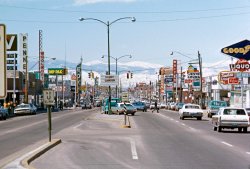
- Pontiac Noir: 1948
- ... . 8x10 acetate negative. View full size.
Miss Neon I recall there were a lot more neon signs around when I was young. It seems that internally lit plastic signs ... Posted by Dave - 01/09/2015 - 12:38am -
![Pontiac Noir: 1948 1948. "George Daniels Pontiac, Van Ness Avenue." The San Francisco car dealer­ship whose interior we've seen here. 8x10 acetate negative. View full size.
Miss NeonI recall there were a lot more neon signs around when I was young. It seems that internally lit plastic signs replaced them but I think the neons were more colorful and vivid.
[As well as more expensive. I miss them too. - Dave]
WowLove these noir shots! Great photography.
(The Gallery, Cars, Trucks, Buses, San Francisco)](https://www.shorpy.com/files/images/SHORPY-188-01A.thumbnail.jpg)























